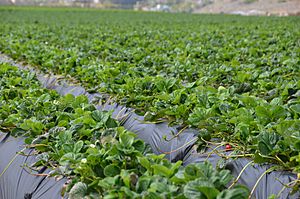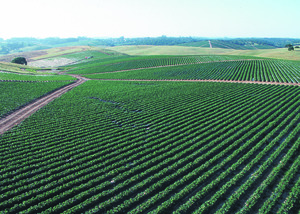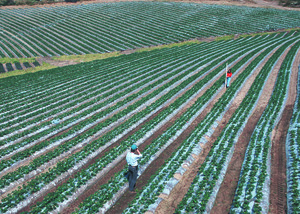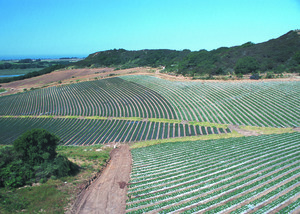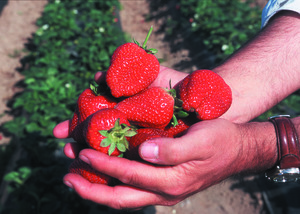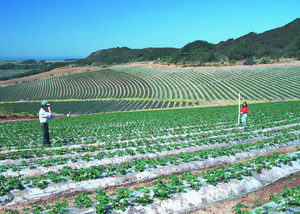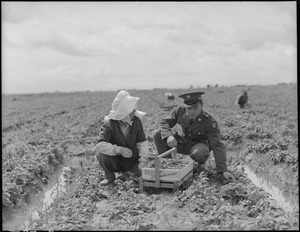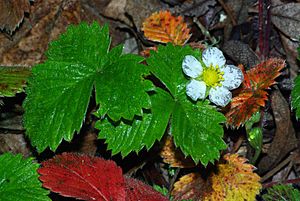Production of strawberries in California facts for kids
Strawberries (Fragaria × ananassa) are a very important crop in the United States, and almost all of them are grown right here in California! In fact, in 2017, California grew 86% of all fresh strawberries and 98% of all frozen strawberries in the country. Florida is the next biggest grower, but it's far behind.
Most of California's strawberries come from a few key areas:
- Monterey County (30%)
- Ventura County (28.6%)
- Santa Barbara County (20%)
- San Luis Obispo County (10%)
- Santa Cruz County (9.2%)
The areas around Watsonville/Salinas (in Santa Cruz/Monterey) and Oxnard (in Ventura) are especially big for strawberry farming.
Strawberry production has grown a lot over the years. In 2005, farmers harvested about 34,300 acres (13,900 ha) of strawberries. By 2017, this had increased to 38,200 acres (15,500 ha). The money earned from these harvests also jumped, from over $1.1 billion in 2005 to more than $3.1 billion in 2017!
The California Strawberry Commission is a group that helps strawberry farmers. They share information with both growers and people who buy strawberries. Some towns even have fun annual strawberry festivals! Companies like Driscoll's started with strawberries in California and are now big names in berries all over the world.
Cal Poly has a special Strawberry Center where they do research and teach farmers the best ways to grow strawberries.
Contents
Growing Strawberries: Money and Workers
Growing strawberries is a big business! In 2017, California produced over 1.4 million tons of strawberries, which were worth more than $3.1 billion. Farmers earned about $1.23 for every pound of strawberries they sold.
Strawberry farms need a lot of people to work. In the summer, when strawberries are ready to be picked, about 50,000 to 60,000 workers are needed. In 2019, Santa Maria became the top strawberry-producing area in California for both regular and organic strawberries. The main growing areas today are Oxnard, Santa Maria, and Salinas–Watsonville.
Protecting Strawberries from Pests
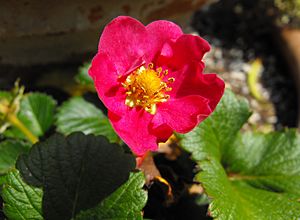
Just like any other crop, strawberries need to be protected from pests and diseases. Farmers use something called Integrated Pest Management (IPM). This is a smart plan that combines different ways to control pests, not just using chemicals.
For strawberry farms in Santa Barbara County, Cooperative Extension SB gives specific advice on how to manage pests and what types of strawberries grow best there.
Scientists are also looking into using robots to help. Robots could monitor fields for insects and even use UV-C light to fight tiny pests like mites.
Diseases of Strawberry
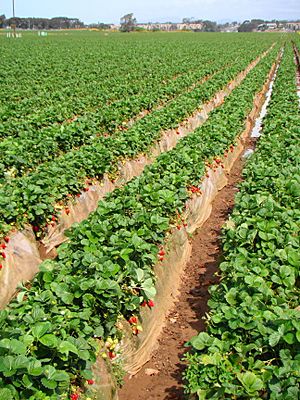
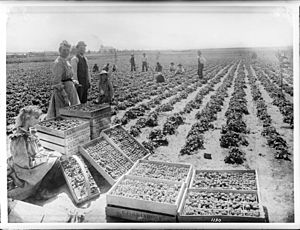
In the past, farmers used a method called soil fumigation to kill harmful things in the soil before planting strawberries. This worked very well and helped strawberry farming grow a lot. However, the most common chemical used, methyl bromide, is being phased out because of environmental concerns.
Now, farmers and researchers are looking for new ways to protect strawberries. One option is 1,3-Dichloropropene for tiny worms called nematodes, but it doesn't work as well in some soils. Another method is Soil solarization, which uses the sun's heat to kill weeds and some diseases. It can get rid of almost all annual weeds, but not all types of weeds.
One of the most common and damaging diseases for strawberries is caused by a fungus called Botrytis cinerea, which causes gray mold. If farmers don't use fungicide sprays or if the weather is too wet and cold, they can lose a lot of their crop, sometimes even all of it!
Strawberry crown rot is another serious disease. Scientists are trying to find genetic markers that show which strawberry plants are naturally resistant to this disease. This would help them breed stronger plants that don't get sick as easily.
The use of drip irrigation (where water slowly drips onto the plants) has helped reduce some diseases like anthracnose in young strawberry plants. For a disease called Fusarium Wilt, the best solution might be to breed strawberries that are naturally resistant. Scientists have found a special dominant gene called Fw1 that gives strawberries strong resistance to this disease.
Powdery Mildew is another common problem. No strawberry type is completely resistant to it, and the sprays used to fight it are becoming less effective over time.
Pests of Strawberry
Insects are always a concern for strawberry farmers. The Beet Armyworm (BAW) is an insect that eats leaves, damages the plant's crown, and then starts eating the berries themselves. This pest is especially common in the southern and Santa Maria strawberry areas.
Farmers control BAW in several ways:
- They use natural enemies, like a tiny wasp called Hyposoter exiguae and a virus that infects the armyworm.
- They manage weeds around the fields, because weeds can be a home for the armyworms.
- Sometimes, they need to use insecticides, especially when planting new strawberries in the southern areas.
For organic farms, they use all the non-chemical methods, plus special organic insecticides.
Birds can have mixed effects. They sometimes eat the strawberries, but they also eat harmful insects. Planting hedgerows (rows of bushes) around fields can attract more birds. In California's Central Valley, fields with hedgerows often have more types of birds and more birds overall. These hedgerows can actually help improve both the amount and quality of strawberries grown nearby!
Weeds and Pests in Strawberry
Common weeds found in strawberry fields include yellow sweetclover, chickweed, annual bluegrass, shepherd's purse, crabgrass, spotted spurge, and yellow nutsedge.
UC Davis's Foundation Plant Services helps farmers by testing strawberry plants for diseases (especially viruses), identifying different strawberry types, and providing healthy plant material for growing new plants.
Lygus bugs, like the Western Tarnished Plant Bug, are also common pests. Farmers sometimes use a special vacuum machine called a "BugVac" to suck up these pests from the strawberry plants.
Treatments in Strawberry
The University of California's IPM program gives advice on choosing the right pesticides, how to use them properly, and how to prevent pests from becoming resistant to the treatments. They also consider how these treatments affect the environment.
Fungicides are often used multiple times each season to fight diseases. Captan is the most common fungicide used. Other common ones include pyraclostrobin, cyprodinil, and fludioxonil. Farmers and nurseries need to work together to use fungicides wisely so that diseases don't become resistant to them over time.
Fumigation was once seen as a huge success for strawberry farming, allowing it to grow a lot. However, with new rules and restrictions on chemicals like methyl bromide, farmers are now looking for other options. The effectiveness of methyl bromide in the past meant that breeders didn't focus much on making strawberries naturally resistant to diseases. Now, with less methyl bromide available, disease resistance is becoming very important again.
One alternative to chemical fumigation for certain soil diseases is called Anaerobic soil disinfestation (ASD), especially when combined with rice bran. This method helps control microbial diseases like Verticillium dahliae.
Breeding New Strawberries
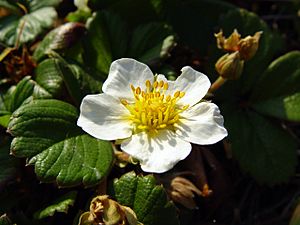

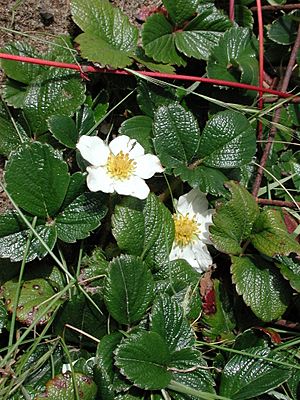
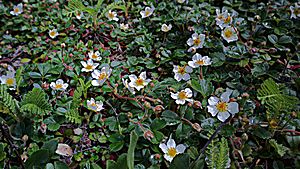

UC Davis is a major center for strawberry breeding in California and around the world. Their breeding program develops new and improved types of strawberries. Sometimes, wild strawberry species like the Woodland Strawberry (F. vesca) are used in breeding to add new traits.
In 2013, two scientists from UC Davis, Douglas Shaw and Kirk Larson, tried to start their own strawberry breeding company using the university's patented varieties. This led to a disagreement and a lawsuit between them and UC Davis. Eventually, they settled the case.
The Cal Poly Strawberry Center doesn't breed new strawberries itself. Instead, it tests the new varieties created by other breeding programs in California to see how well they resist diseases.
Driscoll's also has its own special breeding program to create unique strawberry varieties.
Some strawberry growing areas in California need "day-neutral" strawberries. These plants produce fruit no matter how long the days are, which is different from "short-day" strawberries that only produce fruit when days are shorter. The ability to be day-neutral was added to modern strawberries from a wild type called F. virginiana ssp. glauca in 1979.
Strawberry Cultivars
A cultivar is a specific type or "variety" of plant that has been developed for certain traits, like taste, size, or disease resistance. UC IPM lists and describes the most common strawberry varieties grown in California.
The University system licenses its new strawberry varieties through its Innovation and Technology Commercialization office. Here are some of the popular UC varieties:
| Day Neutral | Short Day | Summer |
|---|---|---|
| Albion | Camino Real | Portola |
| Cabrillo | Gaviota | UCD Finn |
| Monterey | Mojave | UCD Mojo |
| San Andreas | Petaluma | |
| Aromas | Ventana | |
| UCD Royal Royce | Benicia | |
| UCD Valiant | Grenada | |
| UCD Moxie | Fronteras | |
| Merced | ||
| Palomar | ||
| UCD Victor | ||
| UCD Warrior |
For Santa Barbara County, farmers are advised to plant both short-day and day-neutral varieties. Some recommended short-day types include 'Benicia', 'Camarosa', 'Camino Real', 'Chandler', 'Mojave', and 'Ventana'. For day-neutral types, 'Albion', 'Monterrey', 'San Andrés', and 'Seascape' are suggested.
As of 2022, twelve nurseries are licensed to grow and sell UC Davis strawberry varieties.
The 'Camino Real' variety grows very well in the Central Coast region. It produces more fruit and larger berries compared to other types like 'Chandler'.
For many years, the use of methyl bromide was so effective at controlling soil diseases that strawberry breeders didn't need to focus on making plants naturally resistant to diseases. But now that methyl bromide is no longer used, breeding for disease resistance has become very important again. Luckily, many existing strawberry types already have good resistance to soil diseases.
Strawberry varieties bred in California are very specialized for this market. They are among the most "inbred" varieties in the world due to intense breeding.
Strawberry farms in Florida often use varieties that were first developed in California. Even countries like Turkey started their modern strawberry industry with California varieties and still rely on them today.
Images for kids
-
Strawberry field, workers harvesting, northwest Oxnard


